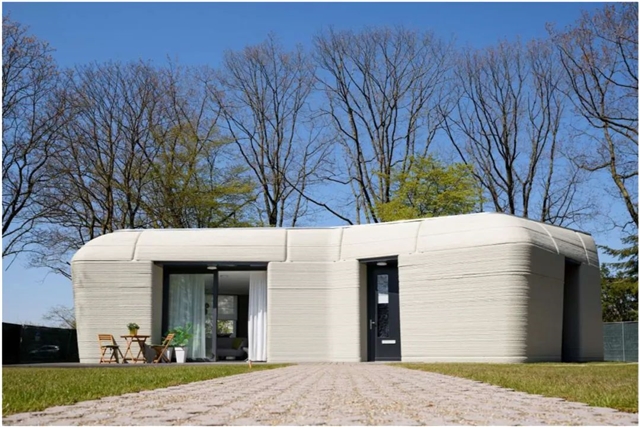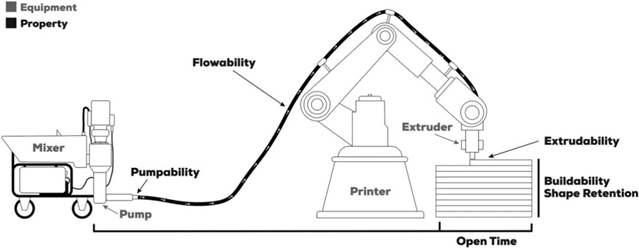|
|
|
|
|
FoAR | 前沿研究:在3D打印建造中探寻新的设计可塑性 |
|
|
论文标题:A road map to find in 3D printing a new design plasticity for construction — The state of art(在3D打印建造中探寻新的设计可塑性)
期刊:Frontiers of Architectural Research
作者:João Teixeira, Cecília Ogliari Schaefer, Bárbara Rangel, Lino Maia, Jorge Lino Alves
发表时间:Apr 2023
DOI: 10.1016/j.foar.2022.05.003
微信链接:点击此处阅读微信文章

FoAR是由高等教育出版社和东南大学建筑学院联合主办的全英文学术期刊
建筑学 / 城乡规划 / 风景园林
本刊已被 A&HCI / CSCD / Scopus / DOAJ 收录
Frontiers of Architectural Research(建筑学研究前沿/FoAR)于4月初在线发布了2023年第二期,共12篇文章。本期推送为其中一篇文章的摘要和大纲,内容采用中文表达,方便大家阅读。推文内容不可直接引用。

01
论 文 题 目
Manuscript Title
A road map to find in 3D printing a new design plasticity for construction – The state of art
在3D打印建造中探寻新的设计可塑性——研究前沿
02
作 者
Authors
Jo ?ao Teixeira (a)*, Cec ??lia Ogliari Schaefer (b), B ?arbara Rangel (a)(c), Lino Maia (a)(d), Jorge Lino Alves (e)
(a) CONSTRUCT, Faculty of Engineering (FEUP), University of Porto, Porto, Portugal
(b) School of Arts, Communication and Hospitality, Architecture and Urbanism, University of the Itaja? ? Valley, Itaja? ?, Brazil
(c) Faculty of Architecture, University of Porto, Porto, Portugal
(d) Faculty of Exact Sciences and Engineering, University of Madeira, Porto, Portugal
(e) INEGI/Faculty of Engineering University of Porto, Porto, Portugal
03
论 文 摘 要
Abstrac
Recent years are showing a rapid adoption of digital manufacturing techniques to the construction industry, with a focus on additive manufacturing. Although 3D printing for construction (3DPC) has notably advanced in recent years, publications on the subject are recent and date a growth in 2019, indicating that it is a promising technology as it enables greater efficiency with fair consumption of material, minimization of waste generation, encouraging the construction industrialization and enhancing and accelerating the constructive process. This new building system not only gives an optimization of the building process but provides a new approach to the building design materiality. The direct connection between design and manufacturing allows the reduction in the number of the various construction phases needed. It is opening a new and wide range of options both formal and chromatic in customization, avoiding complex formworks, reducing costs and manufacturing time. The creative process has a strict and direct link with the constructive process, straightening design with its materiality. Cement-based materials lead the way, but new alternatives are being explored to further reduce its carbon footprint. In order to leverage its sustainability and enhance the system capacity, initiatives are being pursued to allow the reduction of the use of PC. Geopolimers are taking the first steps in 3DPC. Construction and Demolition Waste (CDW) materials are used to substitute natural aggregates. Even soil is being explored has a structural and aesthetic material. These research trends are opening a wider range of possibilities for architecture and design, broadening the spectrum of color, texture, and formal variations. The concern about textures and colours is not yet evident in many the structures already printed, opening the opportunity for future research. More can be done in the mixture and formal design of this building system, “discovering” other raw materials in others waste.This article aims to make a critical review of technologies, materials and methodologies to support the development of new sustainable materials to be used as a plastic element in the printed structure. A roadmap of 3D printing for construction is presented, and an approach on mix design, properties in the fresh and hardened state, highlighting the possibilities for obtaining alternative materials are pointed. With this review possible directions are presented to find solutions to enhance the sustainability of this system discovering “new” materiality for architecture and design.
近年来,数字化制造技术在建筑行业内得到了迅猛的发展和广泛的采用,主要集中于增材制造(additive manufacturing)。虽然3D打印建筑(3DPC)近年来取得了显著的进步,然而与此技术相关的出版物于2019年才慢慢增多起来。由此可见,3D打印建筑因为可以提升材料的合理消耗、最大限度地减少废料的产生、鼓励建筑工业化、增强和减速建设过程,而被认为是一项具备前途的技术。这类新兴的建造体系不仅优化了建设过程,而且为建筑设计的材料性提供了一种新的方法。设计与建造之间的直接联系可以缩减施工阶段。其色彩和形式的定制上提供了一种新的更加广泛的选择,避免使用复杂的模具,从而减少建造成本和建造时间。创作过程与建构过程有着严格而直接的联系,通过材料来矫正设计。水泥基材料处于领先地位,然而人们正探索新的替代材料,以进一步减少碳足迹。为了提高建造系统的可持续性和体量,目前正采取措施来减少打印建筑的使用。地聚合物(Geopolimers)率先迈出了3D打印建筑的第一步。建筑固废(CDW)可以被用来代替天然的骨料。甚至是土壤也被探索可成为具备结构美学的建筑材料。这些研究趋势为建筑和设计开辟了更加广泛的可能性——拓宽了材料色彩、材质和形式变化的范畴。在很多已打印建成的结构中对材料材质和颜色的关注并不显著,这为未来的研究提供了机会。在此建造体系中的混合与正式设计中还有很多研究可以做,可以在其他废料中“发现”更多其他的原材料。本文旨在对技术、材料和方法进行批判性的回顾,以支持在3D打印结构中那些新的可持续材料能够更好地发展成为一种可塑性的建筑元素。本文提出了3D打印用于建造的路线图,并指出了混合设计方法,以及在材料新鲜和固化的不同状态下的材料性能,强调了获取代替材料的可能性。通过这一回顾,本文提出了可能的方向,并寻求解决方案,从而增强了建造体系的可持续性,发现建筑与设计中“新的”材料性。
04
关 键 词
Keywords
3D printing / 3D打印
Architecture / 建筑
Construction / 建造
Materials development / 材料开发
Textures / 材质
05
章 节 标 题
Sections Title
1. Introduction / 引言
2. Research methodology / 研究方法
3. 3DPC materiality in architecture and design / 建筑与设计中3D打印的材料性
4. 3DP for construction world roadmap / 3D打印在建造中的路线图
5. Fresh properties for a 3D printable material / 3D打印软材料的性能
6. Characterization in the hardened state / 打印材料在硬化状态下的描述
6.1. Mechanical performance / 机械性能
6.2. Durability / 持久性
6.3. Textures and colours / 材质与颜色
7. Trends in the developing of more sustainable mortars for 3DP: 3D打印中生态砂浆发展趋势
7.1. Options to improve sustainability in PC-based materials / 提升基于打印建筑材料可持续性的选择
7.1.1. Supplementary cementitious materials in 3D printing / 3D打印中对水泥基材料的补充
7.1.2. Alternative aggregates / 替代骨料
7.1.3. Chemical admixtures / 化学添加剂
7.2. Geopolymeric materials / 地聚物材料
7.3. Soil and clay-based materials / 土壤与粘土基材料
7.4. Gypsum-based materials / 石膏基材料
7.5. 3D metal printing / 3D金属打印
8. Conclusion / 结论
06
主 要 插 图
Illustrations

▲ 图一:采用不同技术和材料所打印的结构。(a)由Mario Cucinella建筑事务所设计,由WASP采用泥土彩印的“Tecla”。© WASP, 2021b。(b/c)由TAM打印的结构,利用3D打印探索新材质与几何体。 © Twente Additive Manufacturing B.V., 2021。(d)Bruil在鹿特丹的材料体验博览会上所展示的对于渐变色彩砂浆的探索。© Bruil, 2021; Bruil and MaterialDistrict, 2016

▲ 图二:建造中所使用的3D打印工艺类型:(a)D-shape 技术,BJ方法 © D-Shape,2010。(b)ME方法,TAM的机械臂打印机 © Twente Additive Manufacturing B.V., 2021。(c)ME方法,WASP的Crane 打印机。

▲ 图三:两种不同类型的3D打印过程产出的不同材质效果。(a)通过D-Shape过程打印出的具有复杂几何结构且无分层纹理的雕塑 © D-Shape,2010。

▲ 图四: Houben & Van Mierlo建筑事务所为Milestone项目设计的3D打印房屋(2018年)。© 本文作者

▲ 图五: 通过材料挤压进行3D打印所需的设备(2018年)。© 本文作者

▲ 图六:3D打印建筑中材料所展现的色彩。© Bruil and MaterialDistrict, 2016; IAAC, 2021; O ?zalp and Yilmaz, 2020; Sika, 2018; WASP, 2021b

▲ 图七:由Neto等人开发的技术打印的3D石膏基材料样品。© Neto et al., 2017
07
作 者 介 绍
Authors Information

Jo ?ao Teixeira
PhD in Spatial Planning
Research Centre José Joaquín de Mora (Cardenas Foundation)
PhD in Spatial Planning at the Faculty of Engineering of the University of Porto. The PhD focus on the role of bike sharing systems in increasing the sustainability and resilience of transport systems during disruptive public health emergencies.
Cec ??lia Ogliari Schaefer
Post-Doctorate
School of Arts, Communication and Hospitality
Architecture and Urbanism, University of the Itaja? ? Valley, Brazil
Graduated in Civil Engineering from the Regional Community University of Chapecó (2004) and Master and PhD in Civil Engineering from the Federal University of Santa Catarina. She interned as a doctoral researcher at the Institut National des Sciences Appliquées de Lyon in 2009. Post-doctorate in Civil Construction at FEUP, Portugal. Civil Engineer of the Court of Justice of the State of Santa Catarina. Professor of the Architecture and Urbanism Course at the University of Vale do Itajaí (UNIVALI). Post-graduation in progress in BIM Manager by PUC Minas.

B ?arbara Rangel
Professor (Associate)
University of Porto, Porto, Portugal
Architect by University of Porto in 1996. The professional carrier started in 1993 working with Alcino Soutinho. In 1995 did an internship at Rafael Moneo Studio. After her diploma in 1996, worked for 5 years in Álvaro Siza’s Office. In 2005 founded with Ana Vale ABprojectos.

Lino Manuel Serra Maia
Assistant Researcher
CONSTRUCT, Faculty of Engineering (FEUP), University of Porto, Porto, Portugal
Member of the R&D unit CONSTRUCT- Institute of R&D in Structures and Construction.Degree in Civil Engineering from FEUP (2005); PhD in Civil Engineering from FEUP (2011). Construction materials, sustainability and circular economy in construction; new building materials; efficient and smart construction; concrete technology; self-compacting concrete; high performance concrete; geopolymer concrete; eco-concrete; recycled concrete; construction and demolition waste; incorporation of waste and by-products from other industries in construction; concrete structures; durability and pathologies in buildings; 3D printing in construction; artificial intelligence in construction; automation and digitalization of construction.

Jorge Lino Alves
Professor (Associate)
INEGI/Faculty of Engineering University of Porto, Porto, Portugal
Jorge Lino Alves currently works at the Mechanical Engineering, INSTITUTO DE CIÊNCIA EM ENGENHARIA MECÂNICA E EM ENGENHARIA INDUSTRIAL. Jorge does research in Additive Manufacturing and Industrial Design. Their most recent publication is Reinforcement of a biopolymer matrix by lignocellulosic agro-waste.
08
原 文 阅 读
Download Link
阅读原文请点击“A road map to find in 3D printing a new design plasticity for construction — The state of art”
▼ 点击下方词条 | 往期精彩不容错过
#期刊快讯#系列
主编王建国院士团队荣获国家科技进步奖一等奖
FoAR|2021年度报告,2022新年快乐!
2021年度ScienceDirect平台各数据TOP10论文榜单
FoAR 2021 CiteScore 指数上升为3.7
JCR 发布 2021 年度 JCI 指标,FoAR 保持全球建筑领域第二
FoAR|2022年度报告,2023新年快乐!
#新刊上线#系列
2023年第一期
2023年第二期
#FoAR投稿指南#系列
1/ 投稿流程
2/ Guide for Author中文版
3/ 审稿流程及发表流程
4/ 如何提交修改稿
5/ 录用文章出版流程
#期刊知识科普#系列
1/ SCI之父尤金·加菲尔德的传奇人生
2/ 国际核心期刊数据库大解析
3/ 手把手教你如何使用最强工具Web of Science
4/ 如何发现一本好期刊
5/ 国内核心期刊有哪些
6/ 版面费与期刊影响力
#精彩文章#系列精选
01/ 城市设计实践发展的多元维度——基于UAL的案例研究
02/ 从智慧城市到共情城市
04/ 传统阿拉伯伊斯兰城市居住区形态学:以传统城市大马士革为例
05/ 建筑遗产预防性保护的意大利视角
06/ 生物与建筑:将科学知识与设计实践相结合的六家法国建筑事务所项目案例研究
07/ 颇具争议的渐进式改造:Elemental建筑事务所金塔蒙罗伊公屋居住区项目的15年
08/ 联合眼动实验和SD法的传统商业街区视觉效果感知评价
10/ 历史的层次:古城堡遗迹中的新建筑改造
13/ 通过空间句法检验帕拉第奥别墅平面中的控制性、中心性和灵活性
15/ 自1931年柯布西耶的Salubra色卡问世后其建筑色彩的偏好:一种跨文化的分析
17/ 建筑师身份的描绘:1920年代末的中国美术建筑师——刘既漂
18/ 探索暴露于风影响下织物的表达与功能
19/ 绿色屋顶能否在地中海气候条件下显著节约能源?基于不同案例的批判性评估
20/ 芬兰近期落成的原木建筑的建构及建筑品质:相关建筑师的解读
21/ 新加坡高校教室光环境品质研究

Frontiers of Architectural Research(建筑学研究前沿 / FoAR)是由东南大学建筑学院和高等教育出版社联合主办的全英文学术期刊,已被A&HCI收录。FoAR 于2012年创刊,双月刊(一年六期),在Elsevier平台上发行,开放获取(Open Access),免费下载。期刊论文涉及领域包括建筑设计与理论、建筑技术科学、城市规划、风景园林、遗产保护等,覆盖建筑学、城乡规划和风景园林三个一级学科。本刊优先发表采用严格科学方法和前沿技术进行研究的学术论文,同时也欢迎探讨建筑社会属性的高水平文章。对所有论文将严格进行同行评议并只接受英文投稿。
期刊联络
刊物邮箱:foar@pub.seu.edu.cn
FoAR英文期刊交流QQ群:21608832
在线投稿
www.editorialmanager.com/foar
刊物主页
http://www.sciencedirect.com/science/journal/20952635
http://journal.hep.com.cn/foar
《前沿》系列英文学术期刊
由教育部主管、高等教育出版社主办的《前沿》(Frontiers)系列英文学术期刊,于2006年正式创刊,以网络版和印刷版向全球发行。系列期刊包括基础科学、生命科学、工程技术和人文社会科学四个主题,是我国覆盖学科最广泛的英文学术期刊群,其中12种被SCI收录,其他也被A&HCI、Ei、MEDLINE或相应学科国际权威检索系统收录,具有一定的国际学术影响力。系列期刊采用在线优先出版方式,保证文章以最快速度发表。
中国学术前沿期刊网
http://journal.hep.com.cn

特别声明:本文转载仅仅是出于传播信息的需要,并不意味着代表本网站观点或证实其内容的真实性;如其他媒体、网站或个人从本网站转载使用,须保留本网站注明的“来源”,并自负版权等法律责任;作者如果不希望被转载或者联系转载稿费等事宜,请与我们接洽。